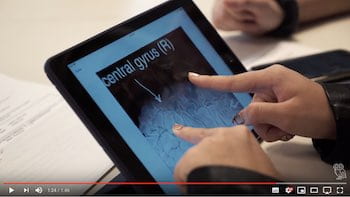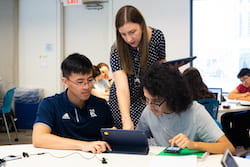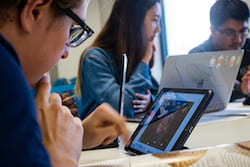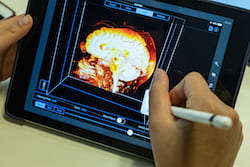NEWS RELEASE
Jeff Falk
713-348-6775
jfalk@rice.edu
Mike Williams
713-348-6728
mikewilliams@rice.edu
Don’t be scared of cutting these bodies
Rice University students dissect virtual anatomy based on real patient scans
HOUSTON – (Oct. 29, 2019) – Who needs pumpkins? Rice University students will spend Halloween afternoon slicing through human bodies to discover the mysteries they contain.
Fortunately, they’ll be less squishy then either a real body or large squash. The students, many of them pre-med, are touring the human anatomy through a program that allows them to study it in great detail without dissecting an actual person.
The Department of Kinesiology’s 300-level Human Anatomy with Lab course has gone virtual this semester. The BodyViz platform employed by Rice lecturers Laura Kabiri and Wendy Schell transforms CAT scan and MRI images of living and cadaveric patients into three-dimensional representations of the body that can be viewed the same way a surgeon probes a patient.
“The images aren’t like the brightly colored cartoons students traditionally see in anatomy books,” Kabiri said. “These are real scans, with red and grey internal organs they can view in 360 degrees.”
After piloting the program with five students over the summer, Rice classrooms are now doing lab work on iPads to study one biological system per week under the direction of Kabiri and Schell.
“They’re all working at their own pace on the same task,” Kabiri said. “They use different images, but with the same goal of labeling the same structures.” Students upload screenshots of their results to complete their assignments.

Rice kinesiology lecturer Laura Kabiri works with An Luu, left, and Robert Montelongo as they probe a three-dimensional brain scan. The students are learning anatomy through a program that allows virtual dissection of patients’ CAT and MRI scans. Photo by Jeff Fitlow
While Rice students were — and still are — able to study cadavers through a collaboration with Baylor College of Medicine, only 12 to 15 can take part each year. That has limited the number of Rice students able to sign up for the in-demand course to kinesiology majors. The introduction of virtual dissection allows the university to offer the course campuswide.
“BodyViz allows them to manipulate the objects in 3D so they get a better feel for where structures are and how they’re related to other structures,” Kabiri said. “But the cool thing about doing it virtually is if they make a mistake, they just hit the reset button.”
Students also have access to parts of the program outside of class to review their work and prepare for the next round, Kabiri said.
She said they seem to particularly enjoy her weekly “medical mysteries.”
“I teach them to identify normal anatomy, but because many of them are pre-med, they like the challenge,” Kabiri said. “I load an abnormal scan and don’t tell them what’s wrong with it. It will be something related to whatever system we’re studying, and it gives them the opportunity to diagnose and think on their feet.”
For Halloween, Kabiri plans to offer her students a trick-and-treat, which will lie somewhere inside the human cardiovascular system, in a limerick:
“Can you find the problem inside?
Go on and give it a try!
For if you are wrong
And it keeps growing strong,
Your patient will surely soon die.”
-30-
Follow Rice News and Media Relations via Twitter @RiceUNews.
Video:
Video produced by Brandon Martin/Rice University
Related materials:
Laura Kabiri: https://kinesiology.rice.edu/laura-kabiri
Wendy Schell: https://kinesiology.rice.edu/wendy-schell
Rice Department of Kinesiology: https://kinesiology.rice.edu
Wiess School of Natural Sciences: https://naturalsciences.rice.edu
Images for download:
https://news2.rice.edu/files/2019/10/0104_BODYVIZ-1-WEB.jpg
Rice University kinesiology lecturer Laura Kabiri works with An Luu, left, and Robert Montelongo as they probe a three-dimensional brain scan. The students are learning anatomy through a program that allows virtual dissection of patients’ CAT and MRI scans. (Credit: Jeff Fitlow/Rice University)
https://news2.rice.edu/files/2019/10/0104_BODYVIZ-2-WEB.jpg
Rice University students learn anatomy with a program that allows for virtual dissection of patients through their CAT and MRI scans. (Credit: Jeff Fitlow/Rice University)
https://news2.rice.edu/files/2019/10/0104_BODYVIZ-3-WEB-1.jpg
Rice University’s Department of Kinesiology is using a virtual dissection program in anatomy labs, allowing more students from multiple disciplines to take the popular course. Students can manipulate three-dimensional representations of bodies based on scans of actual patients. (Credit: Jeff Fitlow/Rice University)
Located on a 300-acre forested campus in Houston, Rice University is consistently ranked among the nation’s top 20 universities by U.S. News & World Report. Rice has highly respected schools of Architecture, Business, Continuing Studies, Engineering, Humanities, Music, Natural Sciences and Social Sciences and is home to the Baker Institute for Public Policy. With 3,962 undergraduates and 3,027 graduate students, Rice’s undergraduate student-to-faculty ratio is just under 6-to-1. Its residential college system builds close-knit communities and lifelong friendships, just one reason why Rice is ranked No. 1 for lots of race/class interaction and No. 4 for quality of life by the Princeton Review. Rice is also rated as a best value among private universities by Kiplinger’s Personal Finance.





